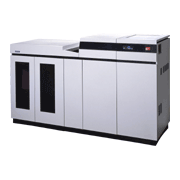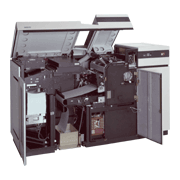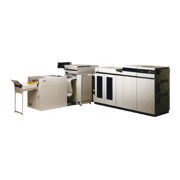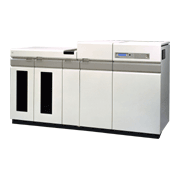This was Fujitsu's top-of-the-line Japanese language line printer (line printer for Japanese language processing), completed in February 1983. At the time, there was a growing need for a high-speed, high-functionality Japanese language line printer due progress in Japanese language information systems. To meet that need, Fujitsu developed the FACOM 6700D ultra high-speed Japanese language line printer. This printer used xerography—a technique where output is written using a laser beam. It had the following features. For the main specifications, see "Specifications of Japanese Language Line Printers".
- 1) High printing quality, high-speed output
- The system printed characters with high printing quality and resolution of 240 dots per inch at a high-speed of 10,600 lines per minute (when printing 6 lines per inch).
- 2) Outstanding ease-of-operation
- With the increase in printing speed, the time required for tasks like loading/replenishing paper and handling printed sheets became the key to high-speed printing output. This printer enabled speedy paper handling by using auto loading and splicing mechanisms for easy paper loading, a high-capacity sliding hopper, and a bidirectional sliding stacker for paper removal.
- 3) A broad range of output functions based on JEF (Japanese processing Extended Feature)
- This system could handle diverse types of output by combining kanji (Chinese character) support for a maximum of 14,336 characters, with form overlay, reduced printing, a copy modification function and other features.
In ultra high-speed printing faster than 10,000 lines per minute, ordinary paper (2,000 sheets per box) had to be loaded roughly once every 10-15 minutes. Post-handling of paper after printing was also very labor intensive and needed to be automated. So equipment was developed to automate pre- and post-handling. One example of such equipment was the ultra high-speed, high-capacity, continuous printing subsystem comprised of the FACOM6700D4 high-speed Japanese language line printer, the FACOM 6898A paper feeder, and the FACOM 6898B paper post-handler. This subsystem was developed with the cooperation of customers, operated in 1985. And by using long paper (35,000 sheets), it could continuously perform a series of printing tasks (form printing, collation, cutting, sorting) for 3.7 hours.
In September 1990, Fujitsu completed the F6700E, a printer which realized multi-media printing functions (diagram printing and image printing) and a bar code printing function. High-speed processing of diagram/image data could previously only be achieved by models with a speed less than 2,000 lines per minute due to limitations on processing speed of the control unit. But the F6700E was the first high-speed model capable of printing diagrams and images. This was achieved by improving processing speed by employing a RISC microprocessor.
| FACOM 6700D | F6700E | ||
|---|---|---|---|
| Completion date | February 1983 | September 1990 | |
| Printing system | Laser-based xerography | ||
| Printing speed | 12 line/inch | 21,200 line/min | |
| 8 line/inch | 14,100 line/min | ||
| 6 line/inch | 10,600 line/min | ||
| Line spacing | 1/6 inch,1/8 inch,1/12 inch (alphanumeric, kana) | ||
| Number of characters printed per line | 136 (alphanumeric, kana),109 (kanji (Chinese characters), approx. 9 point size), 68 (kanji (Chinese characters), approx. 12 point size) |
||
| Resolution | Both vertical and horizontal: 240 dot/inch | ||
| Character composition | Alphanumeric, Kana: 24×30 dot,Kanji (Chinese characters): 30×30 dot | ||
| Character generation mechanism | Basic | Alphanumeric, Kana 255 char | |
| JIS Level 1 and JIS Non-Kanji (3,418 char) | Optional | Basic | |
| Loadable character types | Max. 14,336 char | Max. 18,432 char | |
| Capable of pattern loading from host computer | |||
| Format printing (Form overlay mechanism) |
Optional | Basic memory capacity: 1MB Max. memory capacity: 10MB (optional) |
|
| Image printing | Not possible | Supported non-compressed, MH compression, MR compression and MMR compression | |
| Connected models | FACOM M Series | ||





